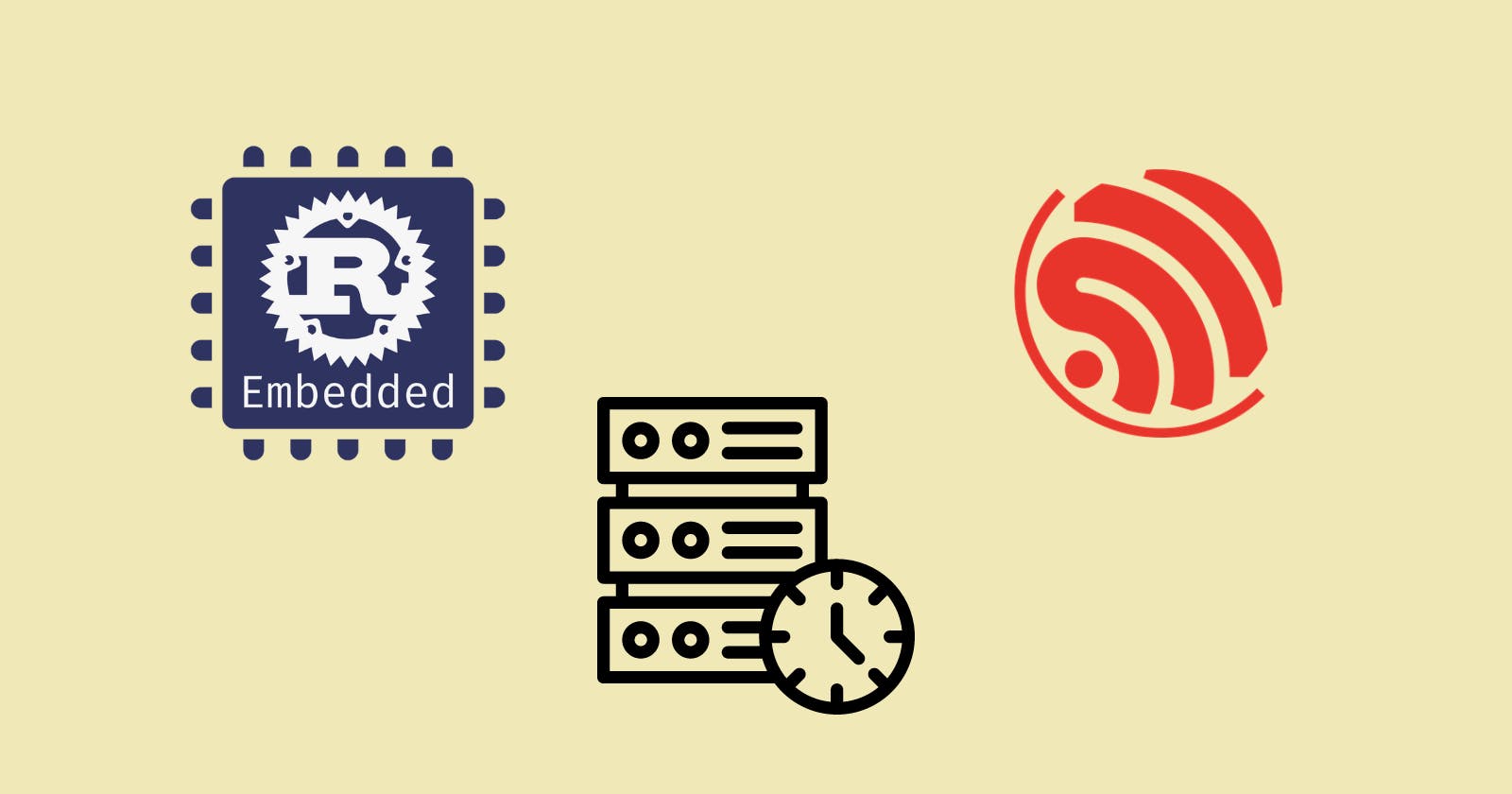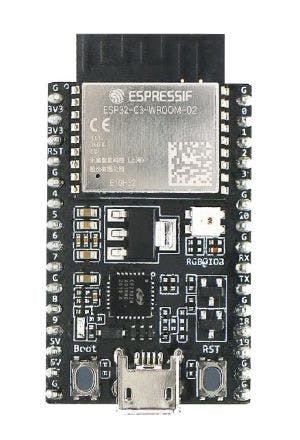This blog post is the fourth of a multi-part series of posts where I explore various peripherals in the ESP32C3 using standard library embedded Rust and the esp-idf-hal. Please be aware that certain concepts in newer posts could depend on concepts in prior posts.
Prior posts include (in order of publishing):
Introduction
In the last post, we understood how to create an HTTP server on an ESP device using the Rust ESP-IDF framework. That also required a connection to WiFi that was established and explained in an earlier post. In this post, we are going to move on to a different application protocol to synchronize device system time with network time using the ESP and Rust. For that, we'll need to use the SNTP protocol that will allow us to retrieve time from the network.
📚 Knowledge Pre-requisites
To understand the content of this post, you need the following:
Basic knowledge of coding in Rust.
Basic familiarity with WiFi & NTP.
💾 Software Setup
All the code presented in this post is available on the apollolabs ESP32C3 git repo. Note that if the code on the git repo is slightly different then it means that it was modified to enhance the code quality or accommodate any HAL/Rust updates.
Additionally, the full project (code and simulation) is available on Wokwi here.
🛠 Hardware Setup
Materials
👨🎨 Software Design
SNTP, which stands for Simple Network Time Protocol, is a protocol used to synchronize computer clocks over a network. In simpler terms, it helps devices like computers, routers, and servers to make sure they all have the same accurate time. Here's how it works:
Requesting the Time:
- A device (Ex. the ESP) sends a request to a time server on the network asking for the current time.
Time Server Responds:
- The time server receives the request and responds by sending back the current time, usually down to the millisecond.
Adjusting the Clock:
- Your device receives the time from the server and adjusts its own clock to match the received time. This ensures that all devices connected to the network are using the same time reference.
Regular Updates:
- SNTP can be configured to periodically sync the time. Devices can send requests at regular intervals to make sure their clocks stay accurate.
SNTP is a simplified version of the Network Time Protocol (NTP). While NTP provides more advanced features and accuracy, SNTP is lightweight and suitable for most basic time synchronization needs, especially in situations where high precision is not critical.
SNTP operates over UDP (User Datagram Protocol) at the transport layer. UDP is a connectionless protocol that provides a lightweight way to exchange data between devices on a network. SNTP uses UDP because it is faster and requires less overhead compared to connection-oriented protocols like TCP. Since time synchronization typically involves sending small packets of data with minimal delay, using UDP makes SNTP a suitable choice for this purpose.
UTC, or Coordinated Universal Time, serves as the global time standard, providing a uniform reference point for timekeeping across different regions. SNTP relies on UTC to provide accurate and standardized time information to devices. When a device using SNTP sends a request for the current time, it receives UTC time from a time server.
In this post, we are going to configure the ESP to obtain the UTC time from an NTP server and print it to the console. The steps include the following:
Configure and Connect to WiFi
Configure SNTP
Synchronize Time
Obtain System Time
Convert Time to UTC time
Print Time
Delay and Go Back to Step 4
👨💻 Code Implementation
📥 Crate Imports
In this implementation, the following crates are required:
The
anyhowcrate for error handling.The
esp_idf_halcrate to import the peripherals.The
esp_idf_svccrate to import the device services (wifi in particular).The
embedded_svccrate to import the neededwifiservice traits.The
std::SystemTimeto obtain system time.The
chronocrate to performDateTimeconversions and time formatting.
use anyhow;
use chrono::{DateTime, Utc};
use embedded_svc::wifi::{AuthMethod, ClientConfiguration, Configuration};
use esp_idf_hal::delay::FreeRtos;
use esp_idf_hal::peripherals::Peripherals;
use esp_idf_svc::eventloop::EspSystemEventLoop;
use esp_idf_svc::nvs::EspDefaultNvsPartition;
use esp_idf_svc::sntp::{EspSntp, SyncStatus};
use esp_idf_svc::wifi::{BlockingWifi, EspWifi};
use std::time::SystemTime;
🎛 Initialization/Configuration Code
1️⃣ Obtain a handle for the device peripherals: Similar to all past blog posts, in embedded Rust, as part of the singleton design pattern, we first have to take the device peripherals. This is done using the take() method. Here I create a device peripheral handler named peripherals as follows:
let peripherals = Peripherals::take().unwrap();
2️⃣ Configure and Connect to WiFi: this involves the same steps that were done in the wifi post.
3️⃣ Create the SNTP Connection Handle: Within esp_idf_svc::sntp there exists an EspSntp abstraction. This is the abstraction needed to set up and configure SNTP. EspSntp contains a new_default method allowing us to configure SNTP with a default configuration. Following that we create an ntp handle as follows:
let ntp = EspSntp::new_default().unwrap();
You can alternatively configure the SNTP with different stnp servers, operating modes, or synchronization modes. For that, there exists a new method and a SntpConf struct in the esp_idf_svc::sntp module.
That's it for Configuration!
📱 Application Code
1️⃣ Synchronize SNTP: Within the EspSntp abstraction, there is a get_sync_status method that is used to obtain the synchronization status. get_sync_status returns a SyncStatus enum indicating whether the SystemTime has been synced. As such, we can ensure synchronization is performed before proceeding as follows:
println!("Synchronizing with NTP Server");
while ntp.get_sync_status() != SyncStatus::Completed {}
println!("Time Sync Completed");
2️⃣ Obtain and Print Time: To obtain the current time we'll need to use the now method in the SystemTime abstraction. The time obtained, however, is not in a desirable format. For that, we can use the chrono crate that allows us to convert to a different type. We'll be converting to the DateTime<Utc> type. Within DateTime is a format method that allows us also format the DateTime String. Here's the full code:
loop {
// Obtain System Time
let st_now = SystemTime::now();
// Convert to UTC Time
let dt_now_utc: DateTime<Utc> = st_now.clone().into();
// Format Time String
let formatted = format!("{}", dt_now_utc.format("%d/%m/%Y %H:%M:%S"));
// Print Time
println!("{}", formatted);
// Delay
FreeRtos::delay_ms(1000);
}
📱Full Application Code
Here is the full code for the implementation described in this post. You can additionally find the full project and others available on the apollolabs ESP32C3 git repo. Also, the Wokwi project can be accessed here.
use anyhow;
use chrono::{DateTime, Utc};
use embedded_svc::wifi::{AuthMethod, ClientConfiguration, Configuration};
use esp_idf_hal::delay::FreeRtos;
use esp_idf_hal::peripherals::Peripherals;
use esp_idf_svc::eventloop::EspSystemEventLoop;
use esp_idf_svc::nvs::EspDefaultNvsPartition;
use esp_idf_svc::sntp::{EspSntp, SyncStatus};
use esp_idf_svc::wifi::{BlockingWifi, EspWifi};
use std::time::SystemTime;
fn main() -> anyhow::Result<()> {
// It is necessary to call this function once. Otherwise some patches to the runtime
// implemented by esp-idf-sys might not link properly. See https://github.com/esp-rs/esp-idf-template/issues/71
esp_idf_sys::link_patches();
let peripherals = Peripherals::take().unwrap();
let sysloop = EspSystemEventLoop::take()?;
let nvs = EspDefaultNvsPartition::take()?;
let mut wifi = BlockingWifi::wrap(
EspWifi::new(peripherals.modem, sysloop.clone(), Some(nvs))?,
sysloop,
)?;
wifi.set_configuration(&Configuration::Client(ClientConfiguration {
ssid: "Wokwi-GUEST".into(),
bssid: None,
auth_method: AuthMethod::None,
password: "".into(),
channel: None,
}))?;
// Start Wifi
wifi.start()?;
// Connect Wifi
wifi.connect()?;
// Wait until the network interface is up
wifi.wait_netif_up()?;
// Print Out Wifi Connection Configuration
while !wifi.is_connected().unwrap() {
// Get and print connection configuration
let config = wifi.get_configuration().unwrap();
println!("Waiting for station {:?}", config);
}
println!("Wifi Connected");
// Create Handle and Configure SNTP
let ntp = EspSntp::new_default().unwrap();
// Synchronize NTP
println!("Synchronizing with NTP Server");
while ntp.get_sync_status() != SyncStatus::Completed {}
println!("Time Sync Completed");
loop {
// Obtain System Time
let st_now = SystemTime::now();
// Convert to UTC Time
let dt_now_utc: DateTime<Utc> = st_now.clone().into();
// Format Time String
let formatted = format!("{}", dt_now_utc.format("%d/%m/%Y %H:%M:%S"));
// Print Time
println!("{}", formatted);
// Delay
FreeRtos::delay_ms(1000);
}
}
Conclusion
NTP is a useful protocol in Internet applications used for synchronizing time. As a result, it can be useful in many projects that require time synchronization. This post introduced how to obtain time from an NTP server on ESP using Rust and the esp_idf_svc crate. Have any questions? Share your thoughts in the comments below 👇.


